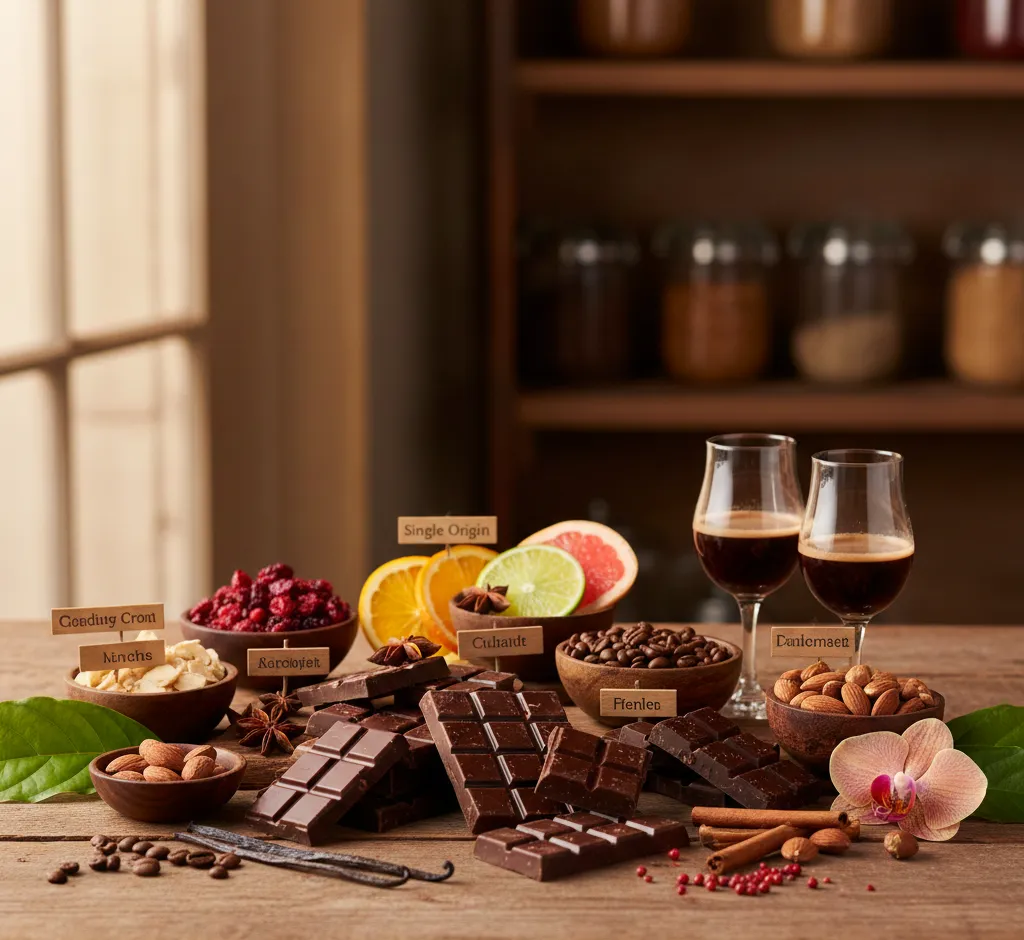Exploring the World of Single Origin Chocolate Flavor Profiles
Dive deep into the fascinating world of single origin chocolate. Explore how terroir, genetics (Criollo, Trinitario, Nacional), and processing influence the unique flavor profiles from regions like Madagascar, Venezuela, and Ecuador.

The journey from bean to bar is a complex and fascinating process, but nowhere is its artistry more evident than in the nuanced world of **single origin chocolate**. Unlike blended or mass-produced bars, single origin chocolate is made exclusively from cocoa beans harvested in one specific geographic location, allowing the unique characteristics of that terroir to shine through. Just as wine connoisseurs discuss the subtle notes imparted by a vineyard's soil and microclimate, chocolate aficionados delve into the distinct flavor profiles born from a single cocoa farm or region.
To truly appreciate single origin chocolate, one must understand that cocoa flavor is not monolithic. It is a spectrum, influenced by a myriad of factors:
- Genetics (The Cocoa Variety): Heirloom varieties like Criollo, Trinitario, and Nacional possess inherently different flavor potentials than the more common Forastero.
- Terroir: The combination of soil, climate, altitude, and surrounding flora in the bean's birthplace.
- Post-Harvest Processing: Crucial steps like **fermentation** and **drying** develop the flavor precursors in the bean.
- Roasting: The bean's roasting temperature and duration unlock and refine the final flavor profile.
The Primary Cocoa Varieties and Their Flavor Foundations
Understanding the fundamental genetic types of the cocoa bean is the first step in decoding a single origin profile. While DNA analysis has revealed a more complex structure, the traditional categories provide a useful framework:
1. Criollo (The 'King' of Cocoa)
Criollo beans are renowned for their **aromatic complexity** and **lack of bitterness** or harshness. They are rare and difficult to grow, making them highly prized. The flavor tends to be delicate, with low acidity.
- Flavor Profile: Notes of caramel, nuts (like almond), vanilla, mild spices, and sometimes a creamy, soft finish.
- Common Origins: Venezuela, parts of Central America, and specific regions in Mexico.
2. Forastero (The Workhorse)
Forastero is the most widely grown cocoa variety, known for its **high yield** and robust, though often simpler, flavor. It forms the backbone of most mainstream chocolate production.
- Flavor Profile: Typically has a strong, classic 'chocolaty' flavor, often accompanied by moderate bitterness, earthy undertones, and sometimes a hint of astringency. High cocoa notes.
- Common Origins: West Africa (Ghana, Côte d'Ivoire), and Brazil.
3. Trinitario (The Hybrid)
A natural hybrid of Criollo and Forastero, Trinitario offers the best of both worlds: the **hardiness and yield** of Forastero combined with the **finer flavor notes** of Criollo. It is a favorite among craft chocolate makers.
- Flavor Profile: Highly diverse, ranging from fruity and floral (from the Criollo lineage) to nutty and robust (from the Forastero lineage). Often features balanced acidity.
- Common Origins: Trinidad (where it originated), Venezuela, Ecuador, and parts of Southeast Asia.
4. Nacional (The Unique Star)
Historically associated with Ecuador, especially the legendary 'Arriba' cocoa. It’s a distinctive variety prized for its unique, highly floral, and delicate flavor.
- Flavor Profile: Prominent **floral notes** (jasmine, orange blossom), tropical fruit, and sometimes a lasting, complex, nutty aftertaste.
- Common Origins: Ecuador and Peru.
Decoding Terroir: A Global Flavor Tour
The magic of single origin chocolate lies in how the cocoa variety interacts with its specific terroir. Below is a detailed look at the signature flavor profiles from major cocoa-producing regions, illustrating how geography dictates taste.
The Americas: Birthplace of Cocoa and Complex Flavors
Venezuela: The Benchmark for Finesse
Venezuelan cocoa is highly sought after, particularly the legendary Criollo strains like Chuao and Porcelana. These beans are the gold standard for delicacy.
- Signature Notes: Rich cream, butterscotch, subtle spices, and a remarkable, long-lasting sweetness. **Low acidity** and bitterness, exceptionally smooth melt.
- Key Flavor Descriptors: Caramel, nuts, vanilla, spice.
Ecuador: Floral and Aromatic
Home to the Nacional variety (Arriba), Ecuadorian chocolate is instantly recognizable by its vibrant, soaring aroma.
- Signature Notes: Intense **floral bouquet** (jasmine, rose), tropical fruits (banana, mango), and sometimes a signature earthy note. **High, bright acidity** is common.
- Key Flavor Descriptors: Floral, fruit-forward, sometimes a unique earthy/tannic quality.
Peru: Andean and Amazonian Diversity
Peru’s cocoa comes from diverse ecosystems, leading to a vast array of profiles. High-altitude beans often exhibit high complexity.
- Signature Notes: Dominant notes of **red berries** (cherry, raspberry), citrus (lime, orange), and often an undertone of spice or dark woods.
- Key Flavor Descriptors: Red fruit, citrus, herbal, nutty.
Dominican Republic: Earthy and Robust
Often Trinitario, the cocoa here is known for its strong, assertive personality, often used in blends but excellent as a single origin.
- Signature Notes: Pronounced **earthy, savory notes**, with hints of tobacco, leather, or wood. Often a slight pleasant sourness and high, classic cocoa intensity.
- Key Flavor Descriptors: Earthy, dark, nutty, sometimes savory.
Africa: Bold and Chocolaty
West African cocoa, predominantly Forastero, sets the global standard for what many consider the 'classic' chocolate flavor—deep, dark, and highly cocoa-forward. However, East African origins are emerging with stunning complexity.
Ghana/Côte d'Ivoire: The Classic Profile
These regions produce the vast majority of the world's cocoa, known for their consistency.
- Signature Notes: The archetypal, powerful **chocolaty taste**. Notes of dark roast coffee, caramel, and a noticeable but balanced bitterness.
- Key Flavor Descriptors: Classic chocolate, dark roast, fudgy, brown spice.
Madagascar: Citrus and Red Fruit Powerhouse
Madagascar is an exciting origin, often showcasing a bright, surprising acidity from its Trinitario and Criollo varieties.
- Signature Notes: Explosive notes of **tart citrus** (grapefruit, lemon) and **red berries** (cranberry, sour cherry). Very high, wine-like acidity.
- Key Flavor Descriptors: Citrus, red fruit, high acidity, wine-like.
Asia & Oceania: Spice and Tropicality
These regions, with their volcanic soils and tropical climates, produce distinctive and often unexpected flavor notes.
Vietnam: Spices and Wood
A newer origin with quickly developing craft chocolate producers, often utilizing Trinitario beans.
- Signature Notes: Complex interplay of spice, such as cinnamon and clove, often mixed with mild red fruit and a smooth, oily texture.
- Key Flavor Descriptors: Spice, wood, cinnamon, pleasant tannin.
Philippines: Herbal and Tropical
Known for its robust, classic-leaning flavor, often with a unique tropical twist.
- Signature Notes: Deep cocoa notes with hints of **tropical herbs** and sometimes coconut or molasses.
- Key Flavor Descriptors: Earthy, herbal, strong cocoa, tropical wood.
The Role of Post-Harvest Processing in Flavor Development
It’s a common misconception that flavor is purely genetic. The truth is, up to **80% of a cocoa bean's final flavor profile** is developed during the post-harvest stages, primarily fermentation and drying.
Fermentation: The Catalyst for Complexity
After harvesting, the beans (still encased in mucilage) are heaped to ferment. This microbial process is critical. The yeast and bacteria convert sugars into alcohol and then into organic acids (like acetic and lactic acid). The heat generated by the process kills the bean, allowing chemical precursors to diffuse and react. A long, well-managed fermentation is necessary to develop key flavor compounds like:
- Esters: Responsible for **fruity and floral** notes.
- Aldehydes: Contributes to **nutty and spicy** notes.
Drying and Roasting: Locking in the Profile
Following fermentation, beans are dried to a specific moisture content. This stops fermentation and locks in the new chemical profile. The final step—**roasting**—is where the chocolate maker exerts the most control over the flavor.
Roasting utilizes the **Maillard Reaction** and **caramelization** to convert the flavor precursors into the rich, complex compounds we recognize as chocolate. A lighter roast preserves the delicate fruit and floral notes of a Criollo bean, while a darker roast will deepen the classic cocoa flavor, emphasize nutty and roasted notes, and mask some of the acidity, regardless of origin.
Key Variables in Roasting:
- Temperature: Lower temperatures (around 120–135°C) preserve bright, volatile notes. Higher temperatures (up to 150°C) push the profile toward roasted, bitter, and classic cocoa notes.
- Duration: Longer roasting times further develop the cocoa profile and reduce overall acidity.
How to Taste and Appreciate Single Origin Chocolate
Tasting single origin chocolate is an experience that engages multiple senses. It requires a deliberate, mindful approach to appreciate the subtle differences.
Step 1: The Visual Examination
Examine the bar. It should have a glossy, uniform color and a clean snap. The color can offer a slight clue: very dark chocolate may indicate a longer roast, while lighter colors might suggest a higher Criollo content or lower roast.
Step 2: The Aroma
Break a piece and deeply inhale. The scent is often a pure distillation of the flavor profile. **What does the nose tell you?** Is it intensely fruity (Madagascar), floral (Ecuador), or deep and earthy (Dominican Republic)?
Step 3: The Melt and Texture
Place a small piece on your tongue and allow it to melt slowly. Note the texture (gritty, smooth, creamy) and how quickly it melts. This is the **mouthfeel**, which significantly impacts the perceived flavor.
Step 4: The Flavor Journey
As the chocolate melts, the flavor compounds are released. Flavor notes often appear in three waves:
- The Initial Impression: The first notes that hit the palate (often acidity or fruit).
- The Core Flavor: The main, sustained notes as the chocolate melts (nutty, spicy, classic cocoa).
- The Finish/Aftertaste: The lingering flavor and sensation after you swallow. Is it clean, sweet, tannic, or bitter? A long, pleasant finish is the mark of high-quality single origin chocolate.
By engaging with single origin chocolate this way, you move beyond simple sweetness and bitterness, entering a world where geography, genetics, and craftsmanship converge to create a truly unique sensory experience. Each bar is a direct, edible expression of a specific place on the planet.


